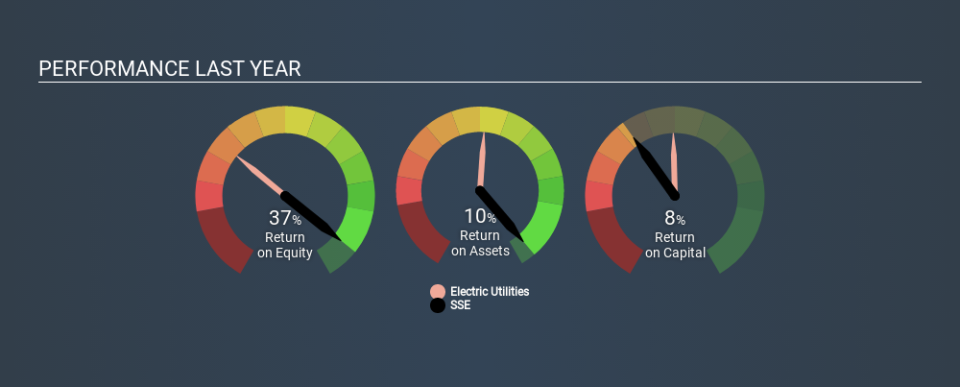Is SSE plc’s (LON:SSE) Return On Capital Employed Any Good?

Today we are going to look at SSE plc (LON:SSE) to see whether it might be an attractive investment prospect. To be precise, we'll consider its Return On Capital Employed (ROCE), as that will inform our view of the quality of the business.
First, we'll go over how we calculate ROCE. Second, we'll look at its ROCE compared to similar companies. Then we'll determine how its current liabilities are affecting its ROCE.
Understanding Return On Capital Employed (ROCE)
ROCE measures the amount of pre-tax profits a company can generate from the capital employed in its business. All else being equal, a better business will have a higher ROCE. Ultimately, it is a useful but imperfect metric. Renowned investment researcher Michael Mauboussin has suggested that a high ROCE can indicate that 'one dollar invested in the company generates value of more than one dollar'.
So, How Do We Calculate ROCE?
Analysts use this formula to calculate return on capital employed:
Return on Capital Employed = Earnings Before Interest and Tax (EBIT) ÷ (Total Assets - Current Liabilities)
Or for SSE:
0.078 = UK£1.2b ÷ (UK£21b - UK£4.9b) (Based on the trailing twelve months to September 2019.)
Therefore, SSE has an ROCE of 7.8%.
Check out our latest analysis for SSE
Is SSE's ROCE Good?
ROCE can be useful when making comparisons, such as between similar companies. We can see SSE's ROCE is around the 6.9% average reported by the Electric Utilities industry. Aside from the industry comparison, SSE's ROCE is mediocre in absolute terms, considering the risk of investing in stocks versus the safety of a bank account. It is possible that there are more rewarding investments out there.
SSE's current ROCE of 7.8% is lower than 3 years ago, when the company reported a 12% ROCE. Therefore we wonder if the company is facing new headwinds. You can click on the image below to see (in greater detail) how SSE's past growth compares to other companies.
When considering this metric, keep in mind that it is backwards looking, and not necessarily predictive. Companies in cyclical industries can be difficult to understand using ROCE, as returns typically look high during boom times, and low during busts. ROCE is, after all, simply a snap shot of a single year. Since the future is so important for investors, you should check out our free report on analyst forecasts for SSE.
Do SSE's Current Liabilities Skew Its ROCE?
Current liabilities are short term bills and invoices that need to be paid in 12 months or less. The ROCE equation subtracts current liabilities from capital employed, so a company with a lot of current liabilities appears to have less capital employed, and a higher ROCE than otherwise. To counter this, investors can check if a company has high current liabilities relative to total assets.
SSE has current liabilities of UK£4.9b and total assets of UK£21b. As a result, its current liabilities are equal to approximately 24% of its total assets. This very reasonable level of current liabilities would not boost the ROCE by much.
The Bottom Line On SSE's ROCE
With that in mind, we're not overly impressed with SSE's ROCE, so it may not be the most appealing prospect. You might be able to find a better investment than SSE. If you want a selection of possible winners, check out this free list of interesting companies that trade on a P/E below 20 (but have proven they can grow earnings).
If you like to buy stocks alongside management, then you might just love this free list of companies. (Hint: insiders have been buying them).
If you spot an error that warrants correction, please contact the editor at editorial-team@simplywallst.com. This article by Simply Wall St is general in nature. It does not constitute a recommendation to buy or sell any stock, and does not take account of your objectives, or your financial situation. Simply Wall St has no position in the stocks mentioned.
We aim to bring you long-term focused research analysis driven by fundamental data. Note that our analysis may not factor in the latest price-sensitive company announcements or qualitative material. Thank you for reading.

 Yahoo Finance
Yahoo Finance 
